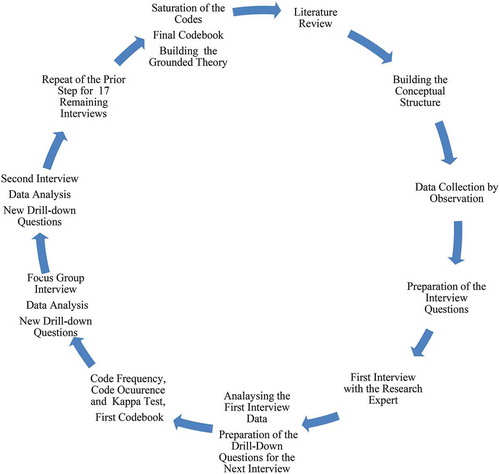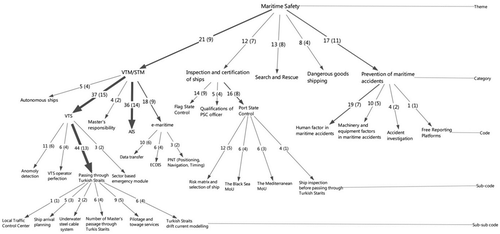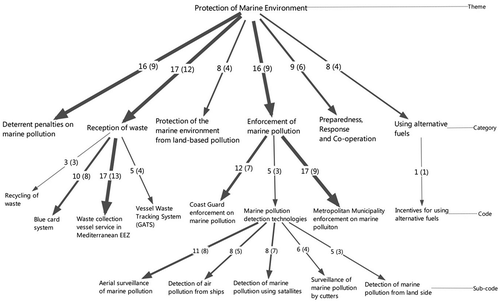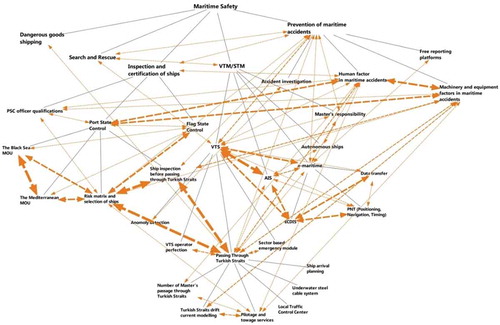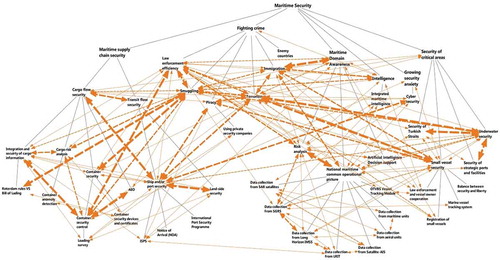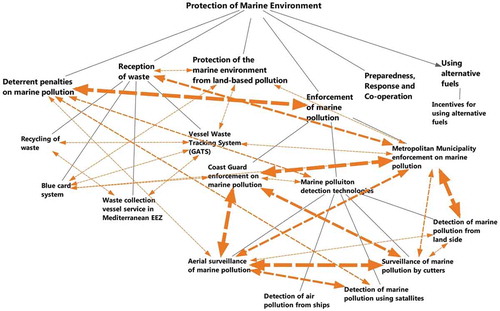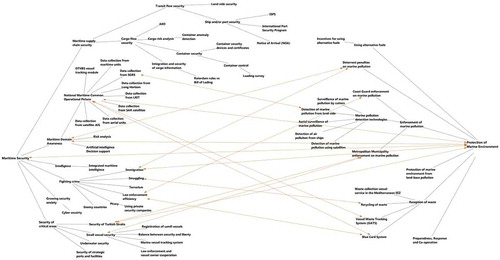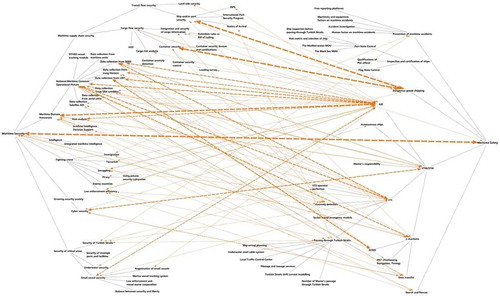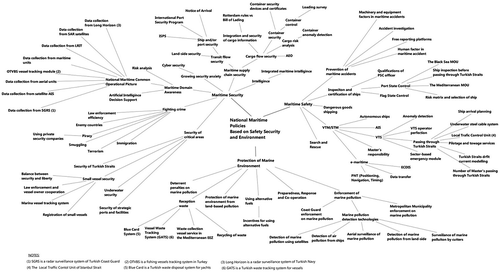ABSTRACT
The aim of this paper is to develop a grounded theory of national maritime policies based on safety, security, and environment by understanding the participants’ experiences. The paper adopts a qualitative research method based on a grounded theory approach and uses primary data collected through three methods, which are interviews, a focus group interview and observations all conducted in Turkey. As a result of analysing the collected data by aid of the MAXQDA software, “The Grounded Theory of National Maritime Policies Based on Safety, Security and Environment” is developed. In this theory, all the constructs of three topics, maritime safety- maritime security-marine environment, are defined separately and intra-topic and inter-topic relationships are revealed. The grounded theory is also a useful guide to help decision makers see all the constructs and the relationships on maritime safety, security, and environment; so they can make accurate and effective maritime policies in this area.
Introduction
Nations have a common interest in facilitating the maritime commerce, sustaining the maritime transportation and protecting against terrorist and criminal. Facilitating maritime trade by the nations is a necessity for their economic security. On the other hand, incidents that occurred in the recent past, such as marine accidents -Exxon Valdez (occurred in1989), Erika (occured in 1999) and Prestige (occured in 2002)- that created significant marine pollution, or September 11 attacks that changed the maritime security paradigm, have required the states to regulate the maritime transportation system (MTS).
Regulation and enforcement on maritime safety, security, and environment are two important tools for nations to organize the MTS. They achieve the regulation and enforcement through international agreements or bilateral or unilateral measures. Uncovering all dimensions and relationships of maritime safety, security, and environment through a grounded theory will bring along to set the right maritime policies which make easy to achieve the balance between facilitation of trade and safe and secure transportation. So, this grounded theory research aims to develop a theory of national maritime policies based on safety, security, and environment by understanding the participants’ experiences.
Glaser (Citation1992, 12) defined the grounded theory as, “a general methodology of analysis linked with data collection that uses a systematically applied set of methods to develop inductive theory about a substantive area.” There are few studies using the grounded theory approach in maritime literature.
De Vries (Citation2015) investigated the success factors for navigational assistance as performed by maritime pilots and Vessel Traffic Service (VTS) operators using a grounded theory-style approach. Mullai and Paulsson (Citation2011) designed a grounded theory model for analysis of marine accidents. Sciberras and Silva (Citation2018) identified the role and challenges of stakeholders at International Maritime Organization (IMO), when implementing the United Nation (UN)’s 2030 Agenda in the international maritime transport domain using a grounded theory approach.
Unlike a grounded theory approach, there is also a study by Kopacz, Morgaś, and Urbański (Citation2001) describing the components of safety at sea, and another study by Thai (Citation2009), describing a conceptual model consisting of 13 dimensions and 24 associated critical success factors for enhancing effective maritime security. All these studies are summarized in the .
table 1. The studies described the constructs and relationships
Safety, security, and environment, often used together, is a well-known trio in maritime. But as can be seen from the literature described above, there is a lack of theory which structure the dimensions of these three topics. The need to develop a grounded theory that identifies all the constructs (dimensions) of safety, security, and environment and determines the relationships of these constructs with each other emerges as an important gap in the literature.
In this study, we investigate whether a grounded theory of national maritime policies based on safety, security, and environment can be developed. Here we analyse all the research data using grounded theory approach, showing that a theory including dimensional and relational elements is developed.
Methodology
There are mostly the risk management studies and the studies using the Multi Criteria Decision-Making (MCDM) methods in the maritime safety and security literature. Inductive methods like preliminary risk analysis (PHA), hazard and operability study (HAZOP), and failure mode and effects analysis (FMEA/FMECA) and deductive method like fault tree analysis (FTA) are usually applied in risk management studies. There are also a number of artificial intelligence (AI) applications to the solving transportation management problems which is knowledge based systems (KBS), neural networks (NN), fuzzy sets (FS), genetic algorithms (GA) and agent-based models (ABM). Combining AI with data analysis, Bayesian Network (BN) also stands out as a tool frequently used in risk management (Boukachour, Fredouet, and Gningue Citation2011, 40–42)
Subjective MCDM methods like analytic hierarchy process (AHP), best-worst method (BWM), simple multi attribute rating technique (SMART), linear programming techniques for multidimensional analysis preferences (LINMAP) and Delphi method are used commonly in the maritime studies together with the objective method like criteria importance through intercriteria correlation (CRITIC). The embedded fuzzy techniques that embed the concept of fuzzy numbers into these classical methods are also used in the latest studies.
MCDM methods aim to compare a set of alternatives by identifying weights for each criterion and are useful to evaluate the options rather than the policies. The studies using these methods usually apply the collected data to the existing theories and try to establish generalizable results.
In this research, it was aimed to develop a grounded theory in the maritime safety, security, and environment fields because the existing literature didn’t have a theory combining these three topics. The research process was conducted through the constructivist grounded theory approach, one of the qualitative research approaches, which aimed to explore participants’ ideas and experiences and developed a theory that went beyond describing the dimensions of national maritime policies based on safety, security, and environment, and also revealed their relations with each other.
As a requirement of the constructivist grounded theory approach led by Bryant (Citation2002), Bryant and Charmaz (Citation2007), Charmaz (Citation2000, Citation2001), Charmaz and Mitchell (Citation1996) and Clarke (Citation2005, Citation2007), attention was paid to representing the opinions of all participants instead of giving priority to analytical codes. Data analysis was not seen as an objective process, subjectivity was accepted throughout the analysis including the researcher impact.
Since the axial coding phase of the systematic grounded theory approach of Strauss and Corbin (Citation1990) encourages the researchers to apply an analytic frame and thus restricts the codes they construct, their approach was not preferred to use in this research.
Sampling and data collection
In the research, initial sampling and theoretical sampling strategies proposed by Charmaz (Citation2006, 100) were used. Snowball sampling strategy other than these two was also used in the research.
Five government offices (a Coast Guard cutter, a VTS centre, a port customs office, a port authority and a metropolitan municipality marine services office) were chosen as the initial sampling in this study. The researcher made observations as either observer as participant or participant as observer. The observations notes held were immediately translated into the text to prevent data loss and made ready for data analysis with MAXQDA software.
The first interviewer, Participant-1, was the other initial sampling of the research. He was also chosen as the research expert due to both his professional experience in the field and his academic career in maritime business administration.
As a result of the first interview, an initial codebook was created after an inter-coder agreement between the researcher and the research expert. In line with codes in this book, another 18 interviewers and 7 participants of focus group interview were determined by using the theoretical and snowball sampling strategies. At least 10 years of experience in the maritime sector, especially in the fields of maritime safety, security, and environment, was sought in the selection of participants.
The average of the experience of 26 participants is 22.5 years. Eight of them worked or are still working as senior executives (top managers) for the state, international organizations or companies. Sixteen of them are ship master and two of them are oceangoing watch keeping officer. Five of them have doctorate degree and seven of them have master degree.
The semi-structured interview questions with theoretical depth could be obtained since they were created as a result of the literature and systematic reviews which were done before commencing the research. The interview questions are provided in the Appendix A. Pilot testing was carried out with the Participant 1, the research expert, to improve the interview questions and technic. Drill-down questions were also improvised by the researcher according to the course of the interview. After each interview, the areas where data collection required at the next interview were determined and drill-down questions were prepared for those areas.
Observations, interviews, and focus group interview presented in the Appendix B in detail were held within the framework of protocols with prior consent. The data of focus group interview that was conducted in two sessions and 13 out of 19 interviews were collected by voice recording. The other six interviews’ data were collected by interview notes. The notes were immediately translated into the text and the tape records were transcribed to prevent data loss, and they were made ready for analysis with MAXQDA software.
It was concluded that the codes created in data analysis reached the point of saturation because the existing codes repeated each other, the dimensions of the codes were defined exactly, and the relationships of the codes with each other were revealed. As a result, the data collection process has been terminated.
From an epistemological perspective in the research, all the interviews were held in the environment in which the participants worked. Focus group meeting was held in a meeting room based on mutual trust in a sincere and collaborative way. Participant verification had been done after data analysis completed.
Data analysis
The data analysis of the research was performed using the Charmaz’s (Citation2006, 42) constructivist approach consisting of two phases: initial and focused coding. In the initial and focused coding, MAXQDA software was used to assist the researcher in organizing his data and coding. The dimensions of the codes and their relations with each other that reflect how the data were interpreted by the researcher could be presented visually with the help of this software. As a result, a grounded theory called a “middle-range theory” by Glaser was developed.
An example that shows how a collected data in the research was coded is presented in . Coding terms used in the coding process were created by the researcher as a result of the literature and systematic reviews which were done before commencing the research, hence they have theoretical depth.
Table 2. An example of data coding process
In the data analysis process with MAXQDA, observation data collected from five government offices was combined and uploaded as a single file in the MAXQDA programme. To be able to present the results in a concise manner, this file was accepted and coded as if it were an interview data file; therefore, the number of the participants is shown as 27 instead of 26 in the study although the real number of participants is 26.
After the interview with Participant 1, he and the researcher coded the transcript of the interview’s tape record separately and inter-coder agreement was done using the three tools of the MAXQDA software: “Code occurrence in the document,” “Code frequency in the document” and “Minimum code intersection rate X% at the segment level.” The results were 87.86%, 75.34% and 86%, respectively. Then, initial codebook was created.
In line with the data obtained in the subsequent interviews, the necessary changes to the initial codebook were made by consensus with Pariticipant-1, the expert of this research. After analysing the data of the last interview, the final codebook of the research was obtained.
In this research, from an ontological perspective, the researcher developed the codes from the data obtained from the participants reflecting the reality of them. Data collection and analysis were interrelated and performed in an ongoing cycle. The data were analysed by constant comparisons. The codes were emerged from raw data (data-driven), not developed a priori from an existing theory. Data collection and analysis process of the research is presented in .
Results
Through the data analysis in this research, the data were grouped as sub-codes, codes, and categories under three themes -maritime safety, maritime security, and protection of marine environment- in order. Descriptive and relational findings belonging to these categories, codes, and sub-codes were obtained using the related tools of the MAXQDA software and are presented below.
Descriptive findings
Descriptive findings of the research revealed the structure of the Grounded Theory of National Maritime Policies Based on Safety, Security, and Environment which is shown in Appendix C. It consists of 3 themes, 17 categories and 86 codes and sub-codes, totally.
Descriptive findings about the themes are elaborated below.
Maritime safety
The categories and codes of this theme are shown in . This theme has 5 categories, 12 codes, 11 sub-codes and 6 sub-sub codes. Some categories and codes of this theme that emerged as important for the participants are: “Passing through Turkish Straits” by 12 participants – 44 times, “Vessel Traffic Service (VTS)” by 15 participants – 37 times, “Automatic Identification System (AIS)” by 14 participants – 36 times, “Vessel Traffic Management (VTM)/Sea Traffic Management (STM)” by 9 participants – 21 times, “Prevention of maritime accidents” by 11 participants – 17 times, “ Port State Control (PSC)” by 8 participants – 16 times and “Human factor in maritime accidents” by 7 participants – 19 times.
Some of the topics mentioned by the participants are: improvement of training to reduce maritime accidents, increasing the efficiency of ship inspection and the number of control officer, building a high Maritime Resource Management (MRM) skilled crew by the companies, feasibility of inspection of the ships before passing Turkish Straits, risk analysis of Ship Master based on the number of passing Turkish Straits, establishing an emergency module in the VTS and development of e-maritime infrastructure. The examples chosen from the statements of the participants regarding this theme are as follows:
There is a concept named STM, a concept similar to that in aviation. It turned out to control all the movements of the ship from departure to arrival. It was produced two projects- Monalisa 1 and Monalisa 2- to evaluate the feasibility of this concept. Monalisa 2 was only made with 20 to 30 ships. I cited Istanbul as an example there: “How will you implement this concept in Istanbul Strait?”- Focus Group Participant 2 (It was coded as the category, “VTM/STM”).
One of the biggest shortcomings in the ships is the reduction of the number of crew due to commercial concerns, and as a result, increased fatigue. It is very important to control this fatigue – Participant 4 (It was coded as the category, “Inspection and certification of ships”).
Maritime security
The categories and codes of this theme are shown in . This theme has 6 categories, 17 codes, 19 sub-codes, 7 sub-sub codes and 1 sub-sub-sub code. Some categories and codes of this theme that emerged as important for the participants are: “National Maritime Common Operational Picture (NMCOP)” by 14 participants – 27 times, “Law enforcement efficiency” by 13 participants – 36 times, “Maritime Domain Awareness (MDA)” by 11 participants – 22 times, “Container security control” by 10 participants – 31 times, “Intelligence” by 10 participants – 21 times, “Small vessel security” by 10 participants – 20 times, “Terrorism” by 10 participants – 17 times, “Smuggling” by 9 participants – 32 times and “Immigration” by 8 participants – 20 times.
Some of the topics mentioned by the participants are: creating an infrastructure that the carrier can see the custom’s records and vice versa, increasing the number of Non-Intrusive Inspection (NII) system and scanning operator for container scanning, development of a container risk analysis software with anomaly detection feature, loading containers at risky import countries under the supervision of loading surveys, establishing a marina tracking system, establishing national Synthetic-Aperture Radar (SAR) satellite system, improvement of underwater security of strategic infrastructure, establishing the infrastructure of cyber security for the future e-maritime and unmanned vessel operations. The examples chosen from the statements of the participants regarding this theme are as follows:
In terms of container transportation, there are two separate operations: customs operation and transportation operation. These two operations are disconnected from each other. I mean that the carrier does not see the customs’ side, and the customs does not see the carrier’s side. Absolutely, the carrier should see the custom’s records, and the customs should see the carrier records. I do not know what integration is provided but we need to see these records instantly in an electronic environment- Participant 7 (It was coded as the sub-code, “Integration and security of cargo information”).
Just seeing the picture at sea does not mean you provide security. It is much more important to evaluate this picture. You must evaluate the picture you see - Participant 2 (It was coded as the code “Risk analysis”).
Protection of marine environment
The categories and codes of this theme are shown in . The last theme of the theory has six categories, eight codes and five sub-codes. Some categories and codes of this theme that emerged as important for the participants are: “Waste collection vessel service in the Mediterranean EEZ” by 13 participants – 17 times, “Reception of waste” by 12 participants – 17 times, “Deterrent penalties on marine pollution” and “Enforcement of marine pollution” by 9s participants – 16s times.
Some of the topics mentioned by the participants are: the importance of education and culture on protection of marine environment, the potential of increasing number of drilling platforms to increase marine pollution in the East Mediterranean, incentives for ships using alternative fuels, penalties including imprisonment by the amount of pollution instead of ship tonnage, improving the treatment plant capacity to reduce land-based pollution, improving the capacity of waste collection in ports, establishing the recycling facilities, waste collection vessel service in Mediterranean EEZ. The examples chosen from the statements of the participants regarding this theme are as follows:
In Turkey, the application of penalty for marine pollution according to ship tonnage is a practice that needs to change. The relevant legislation should be rearranged according to the amount of pollution- Participant 19 (It was coded as the category “Deterrent Penalties on Marine Pollution”).
It has been informed that the 1700 tons of Coast Guard ships, which have recently entered the inventory, have an environmental pollution control system that prevents the spread of pollution, removes the pollutants, and has the ability to function under the OPRC 90- Data Obtained from Observation in TCG 90 (It was coded as the category “Preparedness, Response and Co-operation”).
Relational findings
Relational findings about the themes are examined under two subtitles.
Relational findings within the themes
Intra-theme relationships of the categories and codes, in other words, the relationships of the subjects mentioned simultaneously by the participants are shown below.
Maritime safety
shows the relationship between the categories and codes of this theme. As an example, it is seen that the participants who talked about “VTS,” also talked about “AIS” simultaneously, which can be concluded that there is a strong relationship between “VTS” and “AIS”; likewise, “The Black Sea Memorandum of Understanding (MoU)” has a strong relationship with “The Mediterranean MoU.” “Passing through Turkish Straits,” “Risk Matrix and Selection of Ship,” and “Ship Inspection before Passing through Turkish Straits” have strong relationships with each other. Also, there are relationships between “Human Factor in Maritime Accidents,” “Machinery and Equipment Factor in Maritime Accidents” and “Port State Control”; likewise, relationships between “Risk Matrix and Selection of Ships,” “The Black Sea MoU,” “The Mediterranean MoU,” and “Flag State Control.” Also, both “VTS” and “AIS” have relationships with “e-maritime” and “Electronic Chart Display and Information System (ECDIS).”
Maritime security
shows the relationship between the categories and codes of this theme. For example, it is seen that the participants who talked about “NMCOP” also talked about “Risk analysis” simultaneously, which can be concluded that there is a strong relationship between these two codes; likewise, there is a strong relationship between “MDA” and “Immigration.” Also, “Container Security Control” has strong relationship with “Integration and Security of Cargo Information,” “Authorized Economic Operator (AEO)” and “Law Enforcement Efficiency.” There is a strong relationship between “NMCOP” and “Risk Analysis” and likewise, “Smuggling” has strong relationship with “Rotterdam Rules vs Bill of Lading,” “Law Enforcement Efficiency” and “Container Security.” On the other hand, “Ship and/or Port Security” has strong relationship with “Cargo Flow Security.” “Land-Side Security” and Underwater Security” have strong relationships with “Terrorism,” “Security of Turkish Straits” and “Security of Strategic Ports and Facilities.” Finally, there is a strong relationship between “Terrorism” and “Small Vessel Security.”
Protection of marine environment
shows the relationship between the categories and codes of this theme. For example, it is seen that the participants who talked about “Deterrent penalties on marine pollution” also talked about “Enforcement of marine pollution” simultaneously, which can be concluded that there is a strong relationship between these two categories. Also, “Aerial Surveillance of Marine Pollution” has a strong relationship with “Surveillance of Marine Pollution by Cutters” and “Coast Guard Enforcement on Marine Pollution”; likewise, “Metropolitan Municipality Enforcement on Marine Pollution” has a strong relationship with “Coast Guard Enforcement on Marine Pollution” and “Detection of Marine Pollution from Land Side.”
Relational findings between the themes
Inter-theme relationships of categories and codes are shown below.
shows that the participants who talked about “VTS” also talked about “Detection of marine pollution from land-side” simultaneously, which shows a strong relationship. Also, there is a relationship between “Inspection and Certification of Ships” and “Coast Guard Enforcement on Marine Pollution.”
When is examined, although there are some non-intensive relations between the categories and codes of “Maritime security” and “Protection of marine environment,” these relations cannot be said to be strong relationships.
shows that the participants who talked about “Maritime Domain Awareness (MDA)” also talked about “AIS” simultaneously; likewise, those who talked about “Maritime Security” also talked about “Maritime Safety.” It has seen that “Dangerous Goods Shipping” has a strong relationship with “Container Security” and “Ship and/or Port Security.” Finally, “NMCOP” has a relationship with “AIS,” “VTS,” and “e-Maritime”; likewise, there is a relationship between “Cyber Security” and “VTM/STM.”
Discussion: what does the grounded theory offer?
Maritime supply chain security consisting of transit and cargo flow security came up as part of maritime security in the developed grounded theory. Considering the terrorist attacks that can be carried out with WMD or the smuggling that supports terrorism, it is quite meaningful that the grounded theory emphasizes the importance of policies related to container anomaly detection and container loading survey in risky countries which both arise in the dimension of cargo flow security. It is another indication of the theory that a system to be created on an international scale to ensure the integration of cargo information between customs and carrier will have a great contribution to the maritime supply chain security.
The emergence of national policies on maritime domain awareness in terms of intelligence, technologies used like reconnaissance radars, SAR satellites, satellite-AIS, and risk analysis that uses the artificial intelligence and decision support is a meaningful indicator for the grounded theory in the context of maritime security. In particular, the grounded theory clearly reveals the importance of the law enforcement efficiency to the fighting crime in maritime domain. In addition, we see that the increasing concern about the cyber security which arises in parallel with the increasing use of technology in maritime, finds its place in this theory.
On the other hand, the emergence of issues related to the security of areas such as the Straits and strategic ports, both above and under the water, as security elements, is very important in terms of maritime transport, considering the USS Cole and M/V Limburg terrorist attacks. Small vessel security has emerged as another element of the theory in ensuring the security of these strategic areas, especially with the dimension of registration and tracking of these small vessels.
In this grounded theory, machinery/equipment factors and human factors in maritime accidents have emerged as the elements of maritime safety, which can be basically called as prevention of maritime accidents. Considering the rescue of victims after maritime accidents and the lessons needed to prevent such an accident from happening again in the future, it is meaningful that search and rescue and accident investigation emerge as the other two elements related to maritime safety.
Again, in the theory, the emerging element regarding the creation of free reporting platforms where ships can report the maritime safety deficiencies they see with each other remains remarkable. On the other hand, considering that port state control and flag state control emerge as an element even in this theory, their importance for maritime safety is once again seen.
While AIS and VTS which is basically based on AIS data emerge as another two important elements of maritime safety in the theory, Master’s responsibility also emerges as an element where the responsibilities of the Master and the VTS operator are questioned in the VTS area. Again, the issues related to how the autonomous ship and e-maritime operations, which will be performed increasingly in the future, will structure the VTM/STM doctrine have emerged as the elements of this theory.
The grounded theory relates maritime safety to maritime security. In this context, AIS, VTS and e-Maritime, which are the important elements of maritime safety, are also related to the NMCOP, which is an element of maritime security, as they are also used for MDA. In the grounded theory, cyber security and VTM/STM are also related to each other due to the increasing data transfer in the maritime domain.
Finally, deterrent penalties and enforcement on marine pollution emerge as two important elements of protection of marine environment in the grounded theory. Especially, the enforcement authority of coast guards (or equivalent agencies) and the use of the marine pollution detection technologies like satellites, aerial units and radars have been come up.
Land-based pollution, which results in approximately 80% percent of all marine pollution, is also an important element of this grounded theory. Reception waste from ships and recycling of waste are the other important issues which the grounded theory reflects.
The grounded theory relates maritime safety to protection of marine environment. In this context, VTS is related to detection of marine pollution on land-side because the radars used in VTSs have also the capability of detection of marine pollution. On the other hand, inspection and certification of ships is related to coast guard enforcement on marine pollution due to the authority of the coast guard both to inspect the ships and to control the maritime pollution.
Conclusions
In this research, “The Grounded Theory of National Maritime Policies Based on Safety Security and Environment” was developed as a result of the analysis of data from 31 different sources using the grounded theory approach with the help of the MAXQDA software. Thanks to the developed grounded theory, national maritime policies based on safety, security, and environment were defined with all constructs and relationships with each other.
In addition to developing a middle-range theory first time in this field, the research has also improved the existing literature. The research participants’ statements related to the navigational assistance as performed by pilots and VTS operators studied by De Vries (Citation2015) were coded under the VTS construct of the theory with many new sub-categories, i.e., statements related to good communication between master, pilot, and VTS identified as vital by De Vries (Citation2015) were coded as the construct of VTS operator perfection in the theory.
The data related to marine accidents were organized under the construct of prevention of maritime accident in the grounded theory. The 11 main constructs of the model by Mullai and Paulsson (Citation2011) were covered under the constructs of “human factor in maritime accidents,” “machinery and equipment factors in maritime accidents,” and “accident investigation” in this theory.
The component of technological and operational ships’ safety described by Kopacz, Morgaś, and Urbański (Citation2001) was detailed under the VTM/STM category of the theory with many new sub-categories (codes). The component of safety of navigation described by Kopacz, Morgaś, and Urbański (Citation2001) was detailed under the construct of the inspection and certification of ships, and prevention of maritime accidents in the grounded theory with many new sub-constructs. The component of prevention of pollution of environment from ships described by Kopacz, Morgaś, and Urbański (Citation2001) was examined extensively under a different theme called protection of marine environment in the theory, and many constructs and sub-constructs were identified.
Although the conceptual model by Thai (Citation2009) aimed to enhance effective maritime security in company level, this study that aimed to determine the constructs of maritime security policies in national level covered the two dimensions of the Thai (Citation2009)’s model- “security risk assessment” and “risk based security mitigation strategies and plans”- in a national perspective. Participant statements related to these two dimensions were coded under the constructs of risk analysis and artificial intelligence-decision support in this theory.
As the constructs of national policies based on maritime safety, security, and environment including relationships with each other have not been studied before, the study may open the field for further studies on a deeper investigation.
Another benefit of this theory is to be a useful guide for practitioners. For example, a manager regarding cargo flow security will be able to easily understand that AEO, integration and security of cargo information, container security, and cargo risk analysis are important elements of cargo flow security. At the same time, he/she can see that “container security” has strong relationships with “integration and security of cargo information,” “AEO,” “law enforcement efficiency,” “smuggling” and “dangerous goods shipping.”
Although the paper suggested useful insights for both researchers and practitioners, the research presents some limitations. First, the universe of the research was limited to Turkey. So, some categories and codes of the theory – 10 codes/sub codes- were only appeared to concern Turkey. These are: Security of Turkish Straits, passing through Turkish Straits (including its six sub-sub code), metropolitan municipality enforcement on marine pollution and waste collection vessel service in the Mediterranean EEZ.
Secondly, the study mainly is a grounded theory research with 31 different data sources from Turkey, so more researches are needed to investigate further constructs and relationship of national maritime policies based on maritime safety, security, and environment.
Highlights
VTS, AIS, and e-maritime are inter-related to Common Operational Picture, which all are used for the MDA.
The customs and the carrier should share the cargo info for an enhanced supply chain security.
Cyber security becomes important with the data transfer need in maritime domain.
Master’s responsibility emerges as a critical issue in the future e-maritime domain.
Waste reception, detection, and punishment are the prominent elements for clean seas.
Declaration of Competing Interest
The authors declare that they have no known competing financial interests or personal relationships that could have appeared to influence the work reported in this paper.
Acknowledgments
We would like to thank Turkish Coast Guard Cutter (TCG)-90, VTS Center-Istinye, Ambarli Customs Office, Tekirdag Port Authority and Marine Services Office of Istanbul Metropolitan Municipality for allowing the research’s observations. We would also like to thank all participants who participated in the research’s interviews. Finally, we would like to thank Prof Dr Hakki Kisi for his continued support throughout this research.
Additional information
Funding
References
- Boukachour, J., C. Fredouet, and M. B. Gningue. 2011. “Building an Expert-System for Maritime Container Security Risk Management.” International Journal of Applied Logistics 2 (1): 35–56. doi:10.4018/jal.2011010103.
- Bryant, A. 2002. “Re-Grounding Grounded Theory.” Journal of Information Technology Theory and Application 4 (1): 25–42.
- Bryant, A., and K. Charmaz. 2007. “Grounded Theory In Historical Perspective: An Epistemological Account.” In The SAGE Handbook Of Grounded Theory, edited by A. Byrant and K. Charmaz, 31–57. London: SAGE Publications.
- Charmaz, K. 2000. “Constructivist and Objectivist Grounded Theory.” In Handbook of Qualitative Research, edited by N. K. Denzin and Y. Lincoln, 509–535. 2nd ed. Thousand Oak: SAGE Publications.
- Charmaz, K. 2001. “Qualitative Interviewing And Grounded Theory Analysis.” In Handbook Of Interview Research, edited by J. F. Gubrium and J. A. Holstein, 675–694. Thousand Oak: SAGE Publications.
- Charmaz, K. 2006. Constructing Grounded Theory: A Practical Guide through Qualitative Analysis. London: SAGE Publications.
- Charmaz, K., and R. G. Mitchell. 1996. “The Myth of Silent Autorship: Self, Substance and Style in Ethnographic Writing.” Symbolic Interaction 19 (4): 285–302. doi:10.1525/si.1996.19.4.285.
- Clarke, A. E. 2005. Situational Analysis: Grounded Theory after the Postmodern Turn. Thousand Oak: SAGE Publications.
- Clarke, A. E. 2007. “Grounded Theory: Conflicts, Debates And Situational Analysis.” In Handbook Of Social Science Methodology, edited by W. Outhwaite and S. P. Turner, 838–885. Thousand Oak: SAGE Publications.
- De Vries, L. 2015. “Success Factors For Navigational Assistance: A Complementary Ship-Shore Perspective.” In D. de Waard, J. Sauer, S. Röttger, A. Kluge, D. Manzey, C. Weikert, A. Toffetti, R. Wiczorek, K. Brookhuis and H. Hoonhout (Eds.), Proceedings Of The Human Factors And Ergonomics Society Europe Chapter 2014 Annual Conference, Lisbon, pp.175–186.
- Glaser, B. G. 1992. Basics of Grounded Theory Analysis: Emergence Vs. Forcing. Mill Valley: Sociology Press.
- Kopacz, Z., W. Morgaś, and J. Urbański. 2001. “The Maritme Safety System, Its Main Components And Elements.” The Journal Of Navigation 54 (2): 199–211. doi:10.1017/S0373463301001205.
- Mullai, A., and U. Paulsson. 2011. “A Grounded Theory Model For Analysis Of Marine Accidents.” Accident Analysis And Prevention 43 (4): 1590–1603. doi:10.1016/j.aap.2011.03.022.
- Sciberras, L., and J. R. Silva. 2018. “The UN’s 2030 Agenda For Sustainable Development And The Maritime Transport Domain: The Role And Challenges Of IMO And Its Stakeholders Through A Grounded Theory Perspective.” WMU Journal Of Maritime Affairs 17 (3): 435–459. doi:10.1007/s13437-018-0147-2.
- Strauss, A., and J. Corbin. 1990. Basics Of Qualitative Research: Grounded Theory Procedures And Techniques. Thousand Oaks: SAGE Publications.
- Thai, V. V. 2009. “Effective Maritime Security: Conceptual Model And Empirical Evidence.” Maritime Policy and Management 36 (2): 147–163. doi:10.1080/03088830902868115.
- Turedi, O. 2019. “Ulusal Denizcilik Politikalarının Uygulanmasında Deniz Trafiğinin Düzenlenmesine Ve Denetlenmesine Yönelik Bir Model Önerisi [A Model Proposal For Regulating and Inspecting The Maritime Traffic in The Application of National Maritime Policies].” PhD diss., Dokuz Eylul University.
Appendix A
Interview questions
How to raise Maritime Domain Awareness (MDA) to end maritime security threats before reaching the mainland?
What methods do you think can be used to keep a cargo imported by sea secure from the manufacturer to the end user during its delivery period?
What are your project suggestions to ensure that small vessels do not pose a security threat at sea?
What are your maritime security policy recommendations to increase the effectiveness of Turkey in its continental shelf and Exclusive Economic Zone (EEZ) in the Eastern Mediterranean?
How do you evaluate the effect of e-maritime on maritime safety, which can be called briefly as managing information between ship-land, land-land and ship-ship?
What do you think should be the features that Vessel Traffic Management (VTM) systems should have?
What are your suggestions to minimize accidents in Turkish maritime jurisdiction areas, especially in Turkish Straits?
What are your suggestions for the development of Port State Control and Flag State Control?
What suggestions can you make regarding the protection of marine environment?
With the 1982 UNCLOS, broad powers have been given to the coastal states in their EEZs to prevent marine pollution. How do you think these powers can be used to increase the effectiveness of Turkey in its EEZ in the Eastern Mediterranean?

